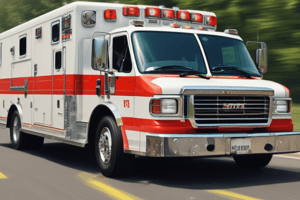Podcast
Questions and Answers
What are EMS systems?
What are EMS systems?
EMS systems consist of a team of healthcare professionals responsible for and providing emergency care and transportation to the sick and injured.
Which of the following is NOT one of the four levels of EMT training?
Which of the following is NOT one of the four levels of EMT training?
- Paramedic
- AEMT
- BLS (correct)
- EMR
What are the licensing criteria for EMTs?
What are the licensing criteria for EMTs?
High school diploma, proof of immunization, valid driver’s license, completion of BLS/CPR course, EMT course, written certification exam, practical exam, and the ability to meet mental and physical criteria.
What is the historic background of the EMS system?
What is the historic background of the EMS system?
Match the level of EMT training with its key skill set:
Match the level of EMT training with its key skill set:
Which of the following is NOT a component of EMS?
Which of the following is NOT a component of EMS?
Flashcards are hidden until you start studying
Study Notes
EMS System Overview
- EMS systems include a team of healthcare professionals providing emergency care and transportation for the sick and injured.
- Originated from funeral homes functioning as ambulances, evolving significantly since the 1960s.
EMT Training and Licensure Levels
- EMR: Basic care prior to ambulance arrival; focuses on immediate interventions.
- EMT: Trained in basic life support, automated external defibrillation, airway adjuncts, and medication assistance.
- AEMT: Advanced life support training, including intravenous therapy and emergency medication administration.
- Paramedic: Extensive training in advanced life support, endotracheal intubation, emergency pharmacology, and advanced assessment.
EMT Licensing Criteria
- Requires a high school diploma, proof of immunization, valid driver’s license, and successful completion of BLS/CPR course.
- Must complete state-approved EMT course and pass recognized written and practical exams.
- Adherence to mental and physical criteria for performing EMT duties is essential.
- The Americans with Disabilities Act (ADA) ensures equal employment opportunities for individuals with disabilities in EMS.
Historical Development of EMS
- The 1966 "White Paper" by the National Academy of Sciences highlighted inadequacies in pre-hospital care and is pivotal for EMS origin.
- The first EMT National Standard Curriculum was developed in the early 1970s, leading to increased educational resources.
- The 1980s saw an emphasis on cardiovascular education and training levels expansion in EMT and Paramedic Curricula.
- In the 1990s, advocacy for a national training curriculum began, influencing layperson training in AED usage.
- The establishment of NEMSES in the 2000s defined four levels of EMS licensure: EMR, EMT, AEMT, and Paramedic.
Skills by EMT Training Level
- EMR: Immediate care skills, including CPR, AED usage, and emergency childbirth.
- EMT: Adds advanced oxygen and ventilation, pulse oximetry, non-invasive BP monitoring, and certain medication administration.
- AEMT: Incorporates advanced airway management, IV and IO access, blood glucose monitoring, and additional medication administration.
- Paramedic: All previous skills, plus advanced management techniques, invasive procedures, and extensive pharmacological interventions.
Components of EMS
- Public Access: Mechanisms for public interaction with EMS.
- Clinical Care: Defined scope of practice and required equipment.
- Medical Direction: Physician oversight ensuring quality patient care.
- Integrated Health Services: Collaboration between pre-hospital and hospital staff for continuity of care.
- Information Systems: Utilize technology to manage EMS data and communication.
- Prevention: EMS role in injury and illness prevention.
- Research: Shift towards evidence-based EMS practices.
- Communications: Essential for system activation, responder dispatch, and medical direction.
- Human Resources: Professionalization efforts within EMS occupations.
- Legislation and Regulation: Compliance with local, state, and federal regulations governing EMS operations.
Studying That Suits You
Use AI to generate personalized quizzes and flashcards to suit your learning preferences.




